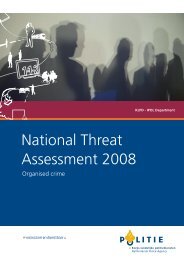Assessing the Effectiveness of Organized Crime Control Strategies ...
Assessing the Effectiveness of Organized Crime Control Strategies ...
Assessing the Effectiveness of Organized Crime Control Strategies ...
You also want an ePaper? Increase the reach of your titles
YUMPU automatically turns print PDFs into web optimized ePapers that Google loves.
<strong>Assessing</strong> <strong>the</strong> <strong>Effectiveness</strong> <strong>of</strong> <strong>Organized</strong> <strong>Crime</strong> <strong>Control</strong> <strong>Strategies</strong>:<br />
A Review <strong>of</strong> <strong>the</strong> Literature<br />
The evidence was found to be significant in relation to just three measures—measures to combat<br />
money laundering, witness protection programs, and reducing <strong>the</strong> supply <strong>of</strong> illegal goods and<br />
services. A “limited” rating was provided in relation to <strong>the</strong> majority (12) <strong>of</strong> <strong>the</strong> measures. In <strong>the</strong><br />
case <strong>of</strong> three measures—anonymous juries, witness immunity, and investigative grand juries—<br />
no evidence regarding <strong>the</strong>ir efficacy was uncovered, o<strong>the</strong>r than <strong>the</strong> anecdotal. Thus, it would<br />
seem that, according to <strong>the</strong> rating scheme employed herein, additional research is required in<br />
relation to 15 <strong>of</strong> 18 control strategies before more conclusive assertions can be made about <strong>the</strong>ir<br />
efficacy.<br />
The third and fourth columns in <strong>the</strong> table indicate some <strong>of</strong> <strong>the</strong> most salient benefits and<br />
shortcomings <strong>of</strong> each OC control measure. The material contained in <strong>the</strong>se columns is<br />
essentially a summary <strong>of</strong> <strong>the</strong> strengths and limitations <strong>of</strong> each measure as discussed in <strong>the</strong><br />
previous chapter. These costs and benefits were considered in arriving at <strong>the</strong> overall<br />
effectiveness rating provided in <strong>the</strong> fifth column.<br />
A number <strong>of</strong> ratings were provided <strong>of</strong> overall effectiveness:<br />
1. An “insufficient data” designation is given where no evidence was found regarding <strong>the</strong><br />
effectiveness <strong>of</strong> a measure or where <strong>the</strong> evidence was not sufficiently conclusive to<br />
provide a rating;<br />
2. A “low” effectiveness rating is used where <strong>the</strong> shortcomings <strong>of</strong> an OC control strategy<br />
seem to considerably outweigh <strong>the</strong> benefits;<br />
3. A “low-moderate” rating is used where a measure has more strengths than those rated<br />
“low” but where <strong>the</strong> costs still outweigh <strong>the</strong> benefits;<br />
4. A “moderate” rating reflects a situation in which <strong>the</strong> strengths and limitations <strong>of</strong> a<br />
measure are fairly balanced;<br />
5. A “moderate-high” rating is used where <strong>the</strong> strengths <strong>of</strong> a measure are considerable and<br />
where <strong>the</strong>y outweigh <strong>the</strong> costs substantially; or, where <strong>the</strong>re is significant evidence <strong>of</strong> <strong>the</strong><br />
effectiveness <strong>of</strong> a measure even where <strong>the</strong> shortcomings may be fairly significant;<br />
6. A “high” rating would be used where both <strong>the</strong> strengths outweigh <strong>the</strong> costs considerably<br />
and where <strong>the</strong> evidence <strong>of</strong> effectiveness is significant.<br />
No rating was provided in relation to one-third (6) <strong>of</strong> <strong>the</strong> measures—anonymous juries, witness<br />
immunity, investigative grand juries, citizen’s/ police commissions/community-based efforts,<br />
intelligence analysis, and legalization <strong>of</strong> illicit goods and services—due to a lack <strong>of</strong> or<br />
insufficient evidence.<br />
A “low” effectiveness rating was provided in relation to four <strong>of</strong> <strong>the</strong> measures—prosecuting OC<br />
kingpins, measures to combat money laundering, seizure and forfeiture <strong>of</strong> assets, and reducing<br />
<strong>the</strong> supply <strong>of</strong> illegal goods and services. With regard to <strong>the</strong> first, prosecution <strong>of</strong> heads <strong>of</strong><br />
criminal organizations, it was found that while <strong>the</strong> US, in particular, has “decapitated” many<br />
prominent groups (especially Cosa Nostra families), <strong>the</strong>se groups have demonstrated<br />
considerable adaptability in maintaining <strong>the</strong>ir operations and <strong>the</strong>re is little evidence that OC<br />
activities have been affected. As for <strong>the</strong> control <strong>of</strong> money laundering, <strong>the</strong>re is strong evidence<br />
from a number <strong>of</strong> countries that, notwithstanding many recent convictions in <strong>the</strong> US, just a small<br />
fraction <strong>of</strong> large or suspicious currency transaction reports lead to investigations. Also, <strong>the</strong>re are<br />
58 | Research and Statistics Division / Department <strong>of</strong> Justice Canada








